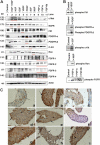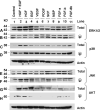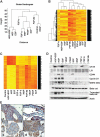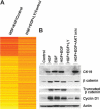Mechanisms of hepatocyte growth factor-mediated and epidermal growth factor-mediated signaling in transdifferentiation of rat hepatocytes to biliary epithelium
- PMID: 18398918
- PMCID: PMC2615562
- DOI: 10.1002/hep.22221
Mechanisms of hepatocyte growth factor-mediated and epidermal growth factor-mediated signaling in transdifferentiation of rat hepatocytes to biliary epithelium
Abstract
Previous studies from our laboratory have demonstrated that hepatocytes can transdifferentiate into biliary epithelium (BE) both in vivo and in vitro; however, the mechanisms are unclear. The current study was designed to investigate the mechanisms of hepatocyte transdifferentiation in vitro. Rat hepatocytes were cultured in roller bottles to obtain hepatocyte organoid cultures, which were stimulated with various growth factors (GFs) including hepatocyte growth factor (HGF), epidermal growth factor (EGF), vascular endothelial growth factor (VEGF), platelet-derived growth factor (PDGF), stem cell factor (SCF), macrophage-stimulating protein (MSP), fibroblast growth factor-a (FGF-a), fibroblast growth factor-b (FGF-b), and fibroblast growth factor-8b (FGF-8b). Only the cultures treated with HGF, EGF, and their combination exhibited formation of hepatocyte-derived biliary epithelium (BE) despite the presence and activation of all the pertinent cognate membrane receptors of the rest of the GFs. Microarray analysis of the organoid cultures identified specific up-regulation of approximately 500 target genes induced by HGF and EGF, including members of the extracellular matrix (ECM) protein family, Wnt/beta-catenin pathway, transforming growth factor beta (TGF-beta)/bone morphogenetic protein (BMP) pathway, and CXC (cysteine-any amino acid-cysteine) chemokines. To investigate the downstream signaling involved in hepatocyte to biliary epithelial cell (BEC) transdifferentiation, we investigated expression and activities of mitogen-activated protein (MAP) kinases [extracellular signal-regulated kinase (ERK)1/2, p38, and c-Jun N-terminal kinase (JNK)/stress-activated protein kinase (SAPK)] as well as serine/threonine kinase AKT. The analysis indicated that AKT phosphorylation was particularly increased in cultures treated with HGF, EGF, and their combination. Whereas phosphatidylinositol 3-kinase (PI3K) inhibitor LY294002 completely inhibited biliary epithelium formation, AKT inhibitor could only moderately reduce formation of BE in the organoid cultures treated with HGF+EGF. Most of the HGF+EGF target genes were altered by LY294002.
Conclusion: Taken together, these data indicate that hepatocyte to BE transdifferentiation is regulated by HGF and EGF receptors and that PI3 kinase-mediated signaling independent of AKT is a crucial component of the transdifferentiation process.
Figures





References
-
- Desmet V, Roskams T, Van Eyken P. Ductular reaction in the liver. Pathol Res Pract. 1995;191:513–524. - PubMed
-
- Cable EE, Isom HC. Exposure of primary rat hepatocytes in long-term DMSO culture to selected transition metals induces hepatocyte proliferation and formation of duct-like structures. Hepatology. 1997;26:1444–1457. - PubMed
Publication types
MeSH terms
Substances
Grants and funding
LinkOut - more resources
Full Text Sources
Other Literature Sources
Research Materials
Miscellaneous
